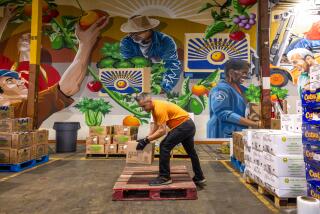Let’s can the food drives
- Share via
The holiday season is here. And in the spirit of the season, millions of people will donate food to food drives. Much of that food will be lovingly packed into boxes and baskets to be distributed to needy families. And just as in years past, such well-intentioned food donations will needlessly leave millions of people hungry. Here’s why.
In the traditional food drive/standardized food box approach, donors are asked to go to the store and buy food or to donate food from their cupboards. It’s then dropped into a collection barrel, or piled around a Christmas tree, or put on the altar of their churches, etc.
For every $10 spent that way, $10 worth of food goes into the charity food distribution system. But if the receiving charity food agency packs and gives out the food in standardized boxes, research has shown that as much as half of the food may not get used. This is not because the receiving family wasn’t needy but because the food is either something they can’t use or don’t know how to use.
So that $10 gift may end up providing only $5 worth of actual hunger relief. What’s more, because donations to food drives are nearly impossible to document for tax deductions, the donor bears the full cost of the $10 donation for what amounts to $5 worth of food used.
By contrast, suppose the donor gave money — not food — to a charity serving the hungry. Three things can happen. First, instead of going to the store to buy food, the charity takes the donated funds to its area’s food bank. There, for every dollar a donor would have spent to buy cans of food, the charity could draw about $20 worth of food. That’s because food banks serve as nonprofit, wholesale-like clearinghouses for the food industry’s surplus food, charging only a nominal handling fee for food drawn by charity agencies. So a $10 donation ends up leveraging as much as $200 worth of food for the charity to distribute.
Second, instead of packing the food into standardized boxes, the charity can display it in a store-like fashion and permit needy families to choose what they like. That practice, called “client choice,” eliminates the problem of needy families being given food they cannot use.
Finally, if donors claim a charitable-gifts tax deduction, the after-tax cost to them in giving $10 could drop to as low as $7.50. Thus, by promoting fund drives instead of food drives, community members can drop the cost of addressing their area’s hunger problem 25% simply by taking maximum advantage of available tax benefits.
The bottom line is that for the same amount of money spent on buying cans for a food drive, donors can feed 20 times more families by providing cash, not cans.
But wait, some argue: Our community food drive engages church members or schoolchildren in a way that writing a check or giving cash simply doesn’t. To which we’d argue: Now is the time to match traditions with impact by demonstrating something that need not be in short supply — creativity! Instead of a canned food drive, have members of your congregation wash out cans used in making a meal, put their donations in the cans and bring them up to the altar. Have schoolchildren volunteer to put the food their financial donations have bought onto the shelves of the local food pantry. Given the amount of food the same amount of money could provide, it might require the whole school to stock the charity’s shelves.
In September, the U.S. Department of Agriculture released its annual report on household food security. What it shows is that 48.8 million Americans lived in food-insecure households in 2010 — households that struggle to feed all members.
In the true spirit of the season, if you really want to help such vulnerable families, go to your local food bank (or to https://www.feedingamerica.org to find one near you). Then take the money you would have used to buy cans for food drives and donate it to that local pantry. Fewer families will go hungry.
John Arnold is the former executive director of Feeding America West Michigan Food Bank, which has distributed 300 million pounds of food aid since 1989. https://www.FeedingAmericaWestMichigan.org
Katherina M. Rosqueta is the founding executive director of the Center for High Impact Philanthropy at the University of Pennsylvania’s School of Social Policy & Practice. The center identifies strategies for donors to get the biggest bang for their buck. https://www.impact.upenn.edu
More to Read
A cure for the common opinion
Get thought-provoking perspectives with our weekly newsletter.
You may occasionally receive promotional content from the Los Angeles Times.









